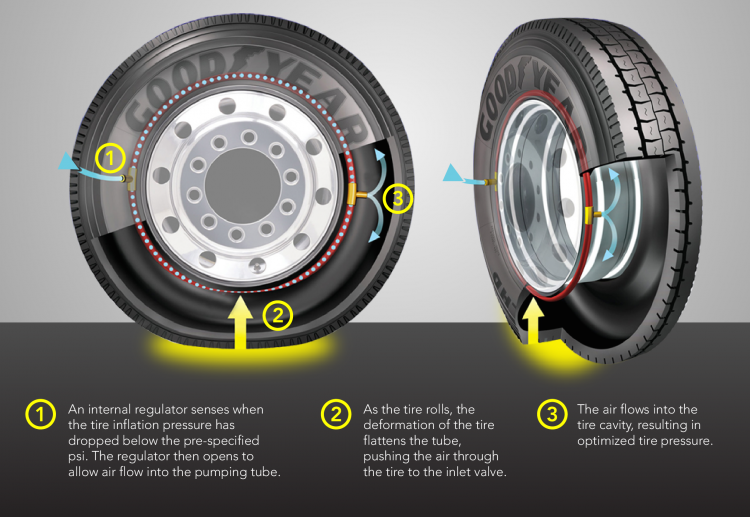Friday, 17/05/2024 | 12:47 GMT+7
You are driving in your car and a dashboard light turns on, notifying you that one of your tires is under-inflated. Eventually you pull over to a gas station, dig out your tire pressure gauge, scrounge up some loose change to pay for the air pump, and reflate the tire to its proper pressure.
It’s a scenario many of us have gone through before but might not have to again, thanks in part to a new Energy Department-funded technology that automatically manages air pressure in tires.
The self-regulating tire system that the Goodyear Tire & Rubber Company has developed with funding from the Office of Energy Efficiency and Renewable Energy (EERE) uses a new technology—called Air Maintenance Technology (AMT)—that works similar to the way muscles push food through the human digestive tract. When the tire’s internal sensor detects a drop in pressure, a valve opens to allow air to enter a tube mounted inside the tire. As the tire moves forward, the weight of the vehicle pushes the air through the tube, filling the tire back to optimal pressure and then closing the valve. All of this happens without any action by the driver.
Maintaining proper tire pressure is one of the most important—but often overlooked—maintenance tasks for vehicle owners. It’s also one of the least expensive ways to increase vehicle fuel economy while saving drivers money.

Under-inflated tires increase a vehicle’s resistance, require the engine to work harder, and use more fuel. In fact, 10% of a vehicle’s useful energy is used to overcome rolling resistance. By keeping tires inflated to the recommended pressure, drivers can improve their gas mileage by up to 3%—the equivalent of saving up to $0.10 per gallon of gasoline. Properly inflated tires also enhance safety, improve vehicle performance, wear evenly, and prolong tread life.
Goodyear is currently testing its award-winning self-inflating tires and the AMT on U.S. trucking fleets. Commercial truck tires are the single largest maintenance cost for fleet operators. Less than 50% of commercial trucks’ tires on today’s highways are functioning at their target pressure, resulting in significantly higher fuel use and transportation costs than necessary. With the improved fuel economy that comes with properly inflated tires, this innovative technology will help save nearly 1.2 billion gallons of petroleum that experts estimate are wasted each year due to underinflated tires.
Goodyear plans to use the data collected to inform the development of self-regulating tires for passenger vehicles.
Combined, these technologies have the potential to improve fuel usage, help consumers save money, and provide concrete steps forward to reach the country’s goals for fuel economy and emissions.
Self-inflating tire technology—just one of EERE’s Energy Impacts.
Truong Duy








.jpg?w=367&h=206&mode=crop) Energy efficiency and conservation usage is an important aspect of the national energy development strategy
05/03/2024
Energy efficiency and conservation usage is an important aspect of the national energy development strategy
05/03/2024
 Challenges and Opportunities to promote energy efficiency market in Vietnam
Challenges and Opportunities to promote energy efficiency market in Vietnam
 The Ministry of Industry and Trade requests government agencies to coordinate in organizing Earth Hour 2024
The Ministry of Industry and Trade requests government agencies to coordinate in organizing Earth Hour 2024
 Consultation on Energy Efficiency Boiler Catalogue and Wood Drying Guideline
Consultation on Energy Efficiency Boiler Catalogue and Wood Drying Guideline
.png?w=367&h=206&mode=crop) Request for expression of interest - C2.1.13: Capacity Building on energy efficiency policies development
Request for expression of interest - C2.1.13: Capacity Building on energy efficiency policies development
 Son Ha Co., Ltd, applies energy efficiency and conservation measures
Son Ha Co., Ltd, applies energy efficiency and conservation measures
 Phuc Kien Co., Ltd., is effectively implementing energy-saving measures
Phuc Kien Co., Ltd., is effectively implementing energy-saving measures
 Request for expression of interest - C2.1.12: Independent monitoring of safeguards implementation
Request for expression of interest - C2.1.12: Independent monitoring of safeguards implementation